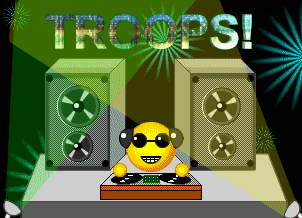|
Posted on 08/02/2013 6:00:46 PM PDT by AZamericonnie
|
Connie, those Papa Murphy pizzas are great! We’d rather go there and have them put something together than to go to any of the sit-down pizzerias in town. And we have some decent ones, here.
Amen. I Believe that too.

Thanks, unique, for the Troops DJ.
Parents, you are responsible for previewing.
Bob Nolan & The Sons of The Pioneers ~ Cool Water
If you would like to be added/removed from the
Canteen Music Ping List, please
FReepmail Kathy In Alaska






His Opus 2 consists of three piano sonatas, the first of which I posted last night. In all three sonatas, Lou steps away from the Haydn and Mozart formula, which is three movements. Lou goes for four movements, one of which is a dance movement.
The Piano Sonata in A, Op. 2/2, was to make a huge impression on Franz Schubert, who was still three years away from birth. It starts quietly, allegro vivace, “quick and lively”, in 2/4. You’d expect the second subject to be in E Major, but Beethoven turns the plot by placing it in E minor but ending it in the proper key after all. The exposition repeats.
At 4:07, he begins his development by using E minor to get to G Major, but he tears off immediately to A-flat to break his first subject apart to a cadence in C Major. The second subject gets worked up in F Major and then into D minor. This battle of the keys is a young master showing off his stuff.
At 5:47 he recaps. The second subject appears now in A minor, then concluding quietly in A Major.
The slow movement is marked largo appassionato, “very slow and passionate”, in 3/4 in D Major. Beethoven slow movements are often conversations with God, and this one speaks of peace and contemplation until 13:03 when it changes to D minor for a stormy passage. But it’s just a minor squall, and it returns to D Major to end quietly and contemplatively.
The third movement is marked as a scherzo, but it’s more of a quick minuet in 3/4 marked allegretto. It’s not to be taken too quickly. He plays games with rhythm; you think a note is on the third beat of a bar, when it’s actually on the second beat. The middle section, or “trio”, is in A minor and adds passion to the movement.
The finale is in 4/4 and A Major, marked grazioso, meaning “graciously”. This is a rondo movement where the first theme will be repeated at various times within the movement as the core idea. For those familiar with Schubert’s Sonata in A, D. 959, the shape of Beethoven’s theme will be awfully familiar. When the A minor section begins, some of us will want to sue Schubert for plagiarism. Beethoven got there 33 years earlier! Beethoven even runs briefly into B-flat before returning to the tonic key, another trick Schubert used in the same sonata.
We’ll run across this again when we get to the Opus 13 sonata, the famous Pathetique in C minor, which inspired another Schubert sonata in the same key.
Did Schubert and Beethoven ever meet? I’ll keep you in suspense, because it will be about three months from now before you get the answer. (Heh heh heh.)
Ah..the eternal Question:
When does Admiration End and Plagiarism Begin?
Sometimes i hear massive chunks of one piece of music (Over 4 bars sometimes)lifted from one piece and plunked down into another. It’s not an issue if it is the same composer (I’ve borrowed from myself too!) But if it’s a whole different person, it’s a very thin line!
In his opera “Fierrabras”, there is a chorus where Schubert stole liberally from Beethoven’s “Fidelio”. Schubert stepped over that line quite a bit at times.
Enjoying Beethoven...thanks, Publius, for sharing his music. ((HUGS))
(HUGS)
Lou is always entertaining, and sometimes he is downright inspiring.
Disclaimer: Opinions posted on Free Republic are those of the individual posters and do not necessarily represent the opinion of Free Republic or its management. All materials posted herein are protected by copyright law and the exemption for fair use of copyrighted works.